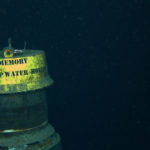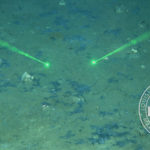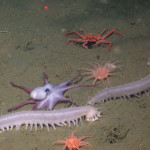 You are a giant swarm of Antarctic krill migrating daily from sunlit surface waters down to the 4500m in the abyss. Some portion of your population is bound to get hungry by the time you reach the bottom. Whattya gonna do? Wait for food to rain down from above?
You are a giant swarm of Antarctic krill migrating daily from sunlit surface waters down to the 4500m in the abyss. Some portion of your population is bound to get hungry by the time you reach the bottom. Whattya gonna do? Wait for food to rain down from above?
Not according to a new article in Current Biology, that illustrates the behavior of Euphausia superba krill that dive into the sediment in deep-water, kick up particles, and scavenge a meal of fallen algae from the seafloor. Secondary production occurs within the benthic boundary layer, in this case, rather than raining down from above.
 The Euphausia superba krill are primarily known as “whale feed”, and they occur in great numbers, up to 30,000 individuals per cubic meter. They account for such high biomass that they have been called “the most successful species on the planet“.
The Euphausia superba krill are primarily known as “whale feed”, and they occur in great numbers, up to 30,000 individuals per cubic meter. They account for such high biomass that they have been called “the most successful species on the planet“.
A recent paper by Dr. Andrew Clarke of the British Antarctic Survey and Dr. Paul A. Tyler of the University of Southampton reports on the discovery of a deep-water refuge for Euphausia superba at 3500m near Marguerite bay in Antarctica that was characterized by high density of krill, with gravid females and many “exuvia”, or floating exo-skeltons that signify near-bottom molting events. Science Daily provides more information on the story.
The research is important because people generally think of the abyssal plain as barren and featureless, but phytodetritus exported from the surface might create patchy spawning habitat and refugia for this keystone species; an important resource to birds, whales, and crabeater seals. The female euphausiids molt after spawning, so one implication of the exuvia described in the paper is that krill may use the abyssal plains as a spawning ground.
Euphausia superba krill are perhaps less than unique because they molt en masse, with hundreds of thousands of individuals synchronously tossing off their coats like its happy hour at the Moulin Rouge.
Image from Woods Hole Oceanographic Institute article on krill in the Southern Ocean. Get yours here.
Citation:
Andrew Clarke and Paul A Tyler. 2008. Adult Antarctic Krill Feeding at Abyssal Depths. Current Biology 18, 282-285. DOI 10.1016/j.cub.2008.01.059





